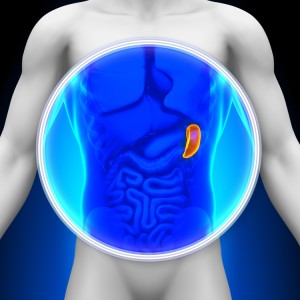Introduction
Another source of left upper abdominal pain can be a ruptured spleen (synonym to splenic rupture).
The most common cause of a ruptured spleen is trauma to the left lower chest wall through an automobile accident, a sports injury or a personal injury. The trauma can lead to a central hematoma, in which case the symptoms are not as obvious and more protracted.
With a direct rupture of the splenic capsule there is massive blood loss into the abdominal cavity with acute symptoms and development of shock. A CT scan will confirm a splenic rupture. Typically the story is that the patient who has a ruptured spleen has been involved in a rollover accident or was kicked into the left lower chest during a sports event. This traumatic event causes a tear in the spleen, which is actively bleeding.
Symptoms
In the rapid course the cause of the ruptured spleen is perhaps more obvious because of the trauma that is apparent, however, with multiple injuries such as bone fractures elsewhere the splenic rupture may initially be overlooked.
There is left upper abdominal pain and problems taking a deep breath in as with full inspiration the diaphragm moves the spleen down somewhat, which is very painful. The blood loss can cause peritonitis with a rock hard abdomen and it can cause collapse and severe anemia. This acute clinical picture can also happen in a patient with a severe course of mononucleosis (Epstein-Barr viral infection). There the spleen can swell very rapidly as a reaction to the virus and the capsule can tear much easier with relatively minor trauma.
In the situation where an inside tear lead to a hematoma within the spleen, the clinical picture is much more subtle and the patient experiences chronic low grade left upper abdominal pain. On examination the physician may feel some fullness in the splenic area and some diffuse tenderness. A CT scan shows the details of the intrasplenic hematoma.
Treatment
These hematomas usually do not stop there. Over time they grow to a larger size and eventually rupture into the abdomen. It is of utmost importance to involve a surgeon to remove the spleen or attempt a spleen preserving surgery.
Frequently the splenic tissue is so fragile that the only surgical option is to remove the spleen. One complication following a splenectomy that the patient is more susceptible to certain bacterial infections. Infections like meningococcal, Haemophilus influenza, pneumococcal, streptococcal and E. coli infections are most common. In a child usually the pediatrician recommends prophylactic antibiotic coverage for about 3 years to prevent these infections to lead to life threatening septicemias. In recent years there has been the addition of several vaccines (pneumococcal vaccine, meningococcal vaccine, haemophilus vaccine), which help the immune system to cope with pneumococcal, meningococcal and haemophilus infections. With all of these tools it no longer is as much a stigma as it was in the past. Removing the spleen is the standard for these cases and the long-term prognosis is good.
References
1. DM Thompson: The 46th Annual St. Paul’s Hospital CME Conference for Primary Physicians, Nov. 14-17, 2000, Vancouver/B.C./Canada
2. C Ritenbaugh Curr Oncol Rep 2000 May 2(3): 225-233.
3. PA Totten et al. J Infect Dis 2001 Jan 183(2): 269-276.
4. M Ohkawa et al. Br J Urol 1993 Dec 72(6):918-921.
5. Textbook of Primary Care Medicine, 3rd ed., Copyright © 2001 Mosby, Inc., pages 976-983: “Chapter 107 – Acute Abdomen and Common Surgical Abdominal Problems”.
6. Marx: Rosen’s Emergency Medicine: Concepts and Clinical Practice, 5th ed., Copyright © 2002 Mosby, Inc. , p. 185:”Abdominal pain”.
7. Feldman: Sleisenger & Fordtran’s Gastrointestinal and Liver Disease, 7th ed., Copyright © 2002 Elsevier, p. 71: “Chapter 4 – Abdominal Pain, Including the Acute Abdomen”.
8. Ferri: Ferri’s Clinical Advisor: Instant Diagnosis and Treatment, 2004 ed., Copyright © 2004 Mosby, Inc.







